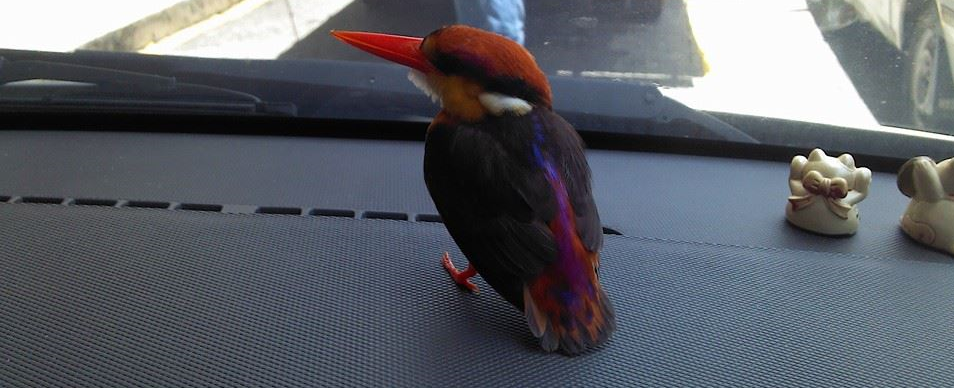
A fantastic world map feature in eBird with my
species number – the world is my (birdwatching) oyster
I
am an eBird user. I have been a birdwatcher before eBird was around. I joined
my friend during her survey in Fraser Hill back in 1998 when the World Wildlife
Fund of Malaysia was about to establish a Nature Centre in the famous “Little
England” of Malaysia. The Fraser Hill Survey was a defining moment in my
birdwatching life, as it re-ignited my interest in birds, with the Silver-Eared
Mesia being the most beautiful montane bird species I have ever seen in Malaysia.
“BIRDS - A Photographic Guide to the Birds of Peninsular Malaysia &
Singapore” by Morten Strange and Allen J (1999, reprinted version) was my first
bird book. Reading it and seeing all 290 species illustrated in pictures mesmerized
me and made me want to learn more about the avifauna of Malaysia and Singapore.
I went birdwatching with my friends from Malacca and Negeri Sembilan, whom I
had met during the first Raptor Watch event in Tanjung Tuan, Port Dickson. Like
birds of a feather that flock together, my friends visited me in Johor a few
times to explore the marshlands and rivers of Segamat. It was common to see
White-Bellied Eagles, Crested Goshawks, Long-tailed Parakeets, Black Hornbills,
Black and Red Broadbills, White-Bellied Woodpeckers, Sooty Barbets (formerly
known as Brown Barbets) back then. Still, with the encroaching activities of
human beings, including sand-mining, construction of a restaurant by the
riverside, an abandoned building and logging, it was getting more difficult to
see these once-common species. I wished eBird had been around for me to enter
the checklists of the lowland birds seen during those visits. I registered my
free account with eBird in 2015. eBird Malaysia, a regional portal to engage
local birders and grow the eBird community throughout Malaysia, was launched in
November 2016. You can read more about that initiative HERE.

Screenshot from eBird Malaysia web portal once
I logged into my page
I
learned how eBird as a tool helps me track the number of bird species I’ve
recorded and entered into my checklists for Malaysia and beyond. Bird sightings contribute to hundreds of conservation decisions and peer-reviewed papers, student projects and help inform bird research worldwide according to eBird science. There are 834
bird species in Malaysia, including Sabah and Sarawak, according to WIKIPEDIA HERE. 16 bird
species are endemic, 19 bird species are introduced by humans and a staggering
63 species of which are globally threatened. Gallus gallus (Red Junglefowl) is one of the bird
species introduced from Asia to the world, leading to domesticated chickens –
is that a good or bad or even ugly introduction? That question deserves a
separate debate altogether. Since my
tally is only 397, I have only seen less than 50% of the total number of bird
species in Malaysia, according to eBird. I have gone on a birdwatching trip to
Sabah before creating my eBird account. The scribbled notes in my pocketbook of
the Birds of Borneo of birds seen during pre-eBird days remain unrecorded in this tool.
Sabah is one of my go-to birding destinations once borders in Peninsular
Malaysia re-open, which I hope will help me pass 400 species in eBird. In some small way, I hope to contribute towards science and conservation, whilst chasing my birdwatching goal.
 This pair of Brown Boobooks (formerly known as the Brown Hawk-owl) was snoozing away that late afternoon on this tree in one of the trails near a housing area in the State of Selangor. It's not easy to see owls nearby the city. Thanks to a birdwatching friend of mine from Malacca who kindly shared the accurate Google Map location with me, I was able to squeeze in some time to birdwatch a bit at the trails. Blue-winged Leafbirds, Crimson-breasted Flowerpecker were surprise finds that afternoon before I arrived at the roosting site of the owls. For purpose of avian study, that afternoon's finding was recorded in a checklist HERE for eBird Malaysia.
This pair of Brown Boobooks (formerly known as the Brown Hawk-owl) was snoozing away that late afternoon on this tree in one of the trails near a housing area in the State of Selangor. It's not easy to see owls nearby the city. Thanks to a birdwatching friend of mine from Malacca who kindly shared the accurate Google Map location with me, I was able to squeeze in some time to birdwatch a bit at the trails. Blue-winged Leafbirds, Crimson-breasted Flowerpecker were surprise finds that afternoon before I arrived at the roosting site of the owls. For purpose of avian study, that afternoon's finding was recorded in a checklist HERE for eBird Malaysia.  Half-asleep Brown Boobook (above pic) compared to fully asleep (below pic)
Half-asleep Brown Boobook (above pic) compared to fully asleep (below pic)












 Laughing is such an important outlet to release stress and tension. Laughing Kookaburra is one such species named to reflect its unique calls which sounds like a series of laughs which you can hear
Laughing is such an important outlet to release stress and tension. Laughing Kookaburra is one such species named to reflect its unique calls which sounds like a series of laughs which you can hear 


